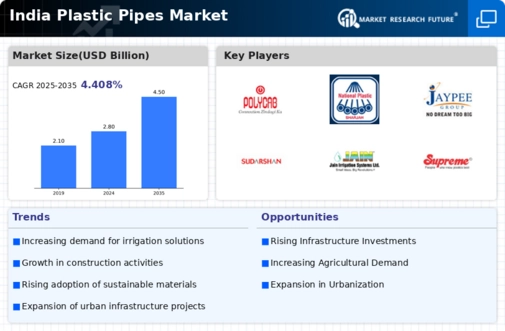Rising Agricultural Demand
Agriculture remains a cornerstone of India's economy, and the rising demand for efficient irrigation systems is significantly impacting the plastic pipes market. With approximately 60% of the population engaged in agriculture, the need for effective water management is paramount. The government has introduced schemes like Pradhan Mantri Krishi Sinchai Yojana, which promotes the use of drip and sprinkler irrigation systems. These systems often utilize plastic pipes due to their durability and flexibility. The market for plastic pipes in agriculture is projected to grow at a CAGR of around 10% over the next few years, indicating a robust demand driven by the need for sustainable farming practices and efficient water usage.
Cost-Effectiveness and Durability
The cost-effectiveness and durability of plastic pipes are pivotal in driving their adoption across various sectors in India. Compared to traditional materials like metal and concrete, plastic pipes offer a lower initial investment and reduced installation costs. Their lightweight nature facilitates easier handling and transportation, which is particularly beneficial in remote areas. Additionally, plastic pipes exhibit a longer lifespan, often exceeding 50 years, which reduces the need for frequent replacements. This aspect is particularly appealing to industries and municipalities looking to optimize their budgets. As the plastic pipes market continues to expand, the emphasis on cost efficiency and long-term performance is likely to remain a key driver.
Urbanization and Housing Projects
The rapid urbanization in India is a significant driver for the plastic pipes market. With urban areas expected to house 600 million people by 2031, the demand for housing and related infrastructure is surging. The government has launched initiatives like the Housing for All scheme, which aims to provide affordable housing. Plastic pipes are increasingly being used in residential construction due to their cost-effectiveness and ease of installation. The market is witnessing a shift towards modern plumbing solutions, where plastic pipes are preferred over traditional materials. This trend is likely to continue, with the plastic pipes market projected to grow by approximately 8% annually as urban housing projects expand.
Water Supply and Sanitation Programs
India's commitment to improving water supply and sanitation is a crucial factor driving the plastic pipes market. The Swachh Bharat Mission and the National Water Policy emphasize the need for efficient water distribution and waste management systems. Plastic pipes are essential in these initiatives due to their resistance to corrosion and lower maintenance costs. The government aims to provide piped water supply to all households by 2024, which could significantly boost the demand for plastic pipes. The market is expected to see a growth rate of around 9% as these programs are implemented, highlighting the essential role of plastic pipes in achieving national sanitation and water supply goals.
Infrastructure Development Initiatives
The ongoing infrastructure development initiatives in India are propelling the plastic pipes market. The government has allocated substantial funds for projects such as urban development, irrigation, and water supply systems. For instance, the National Infrastructure Pipeline aims to invest over $1.4 trillion by 2025, which is likely to enhance the demand for plastic pipes. These pipes are favored for their lightweight, corrosion resistance, and ease of installation, making them suitable for various applications. As urbanization accelerates, the need for efficient water management systems becomes critical, further driving the plastic pipes market. The increasing focus on sustainable infrastructure also suggests a shift towards using plastic pipes, which can be recycled and have a lower environmental impact compared to traditional materials.

















Leave a Comment